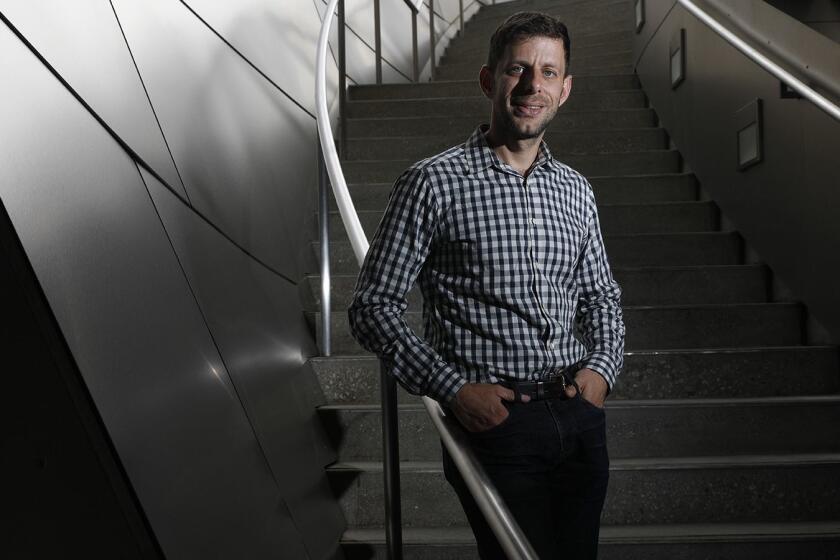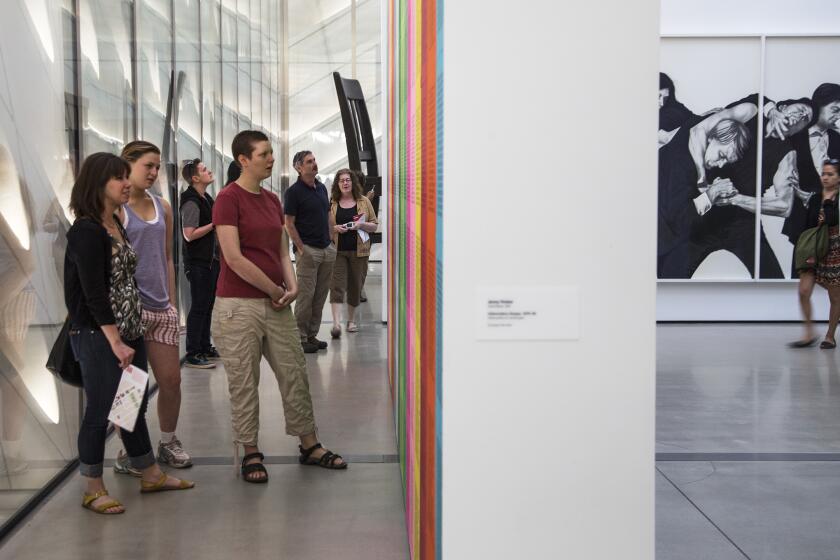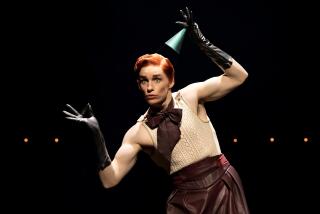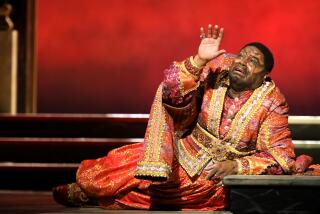Review: The Kanye West opera at the Hollywood Bowl? Call it ‘Nebuchadsnoozer’
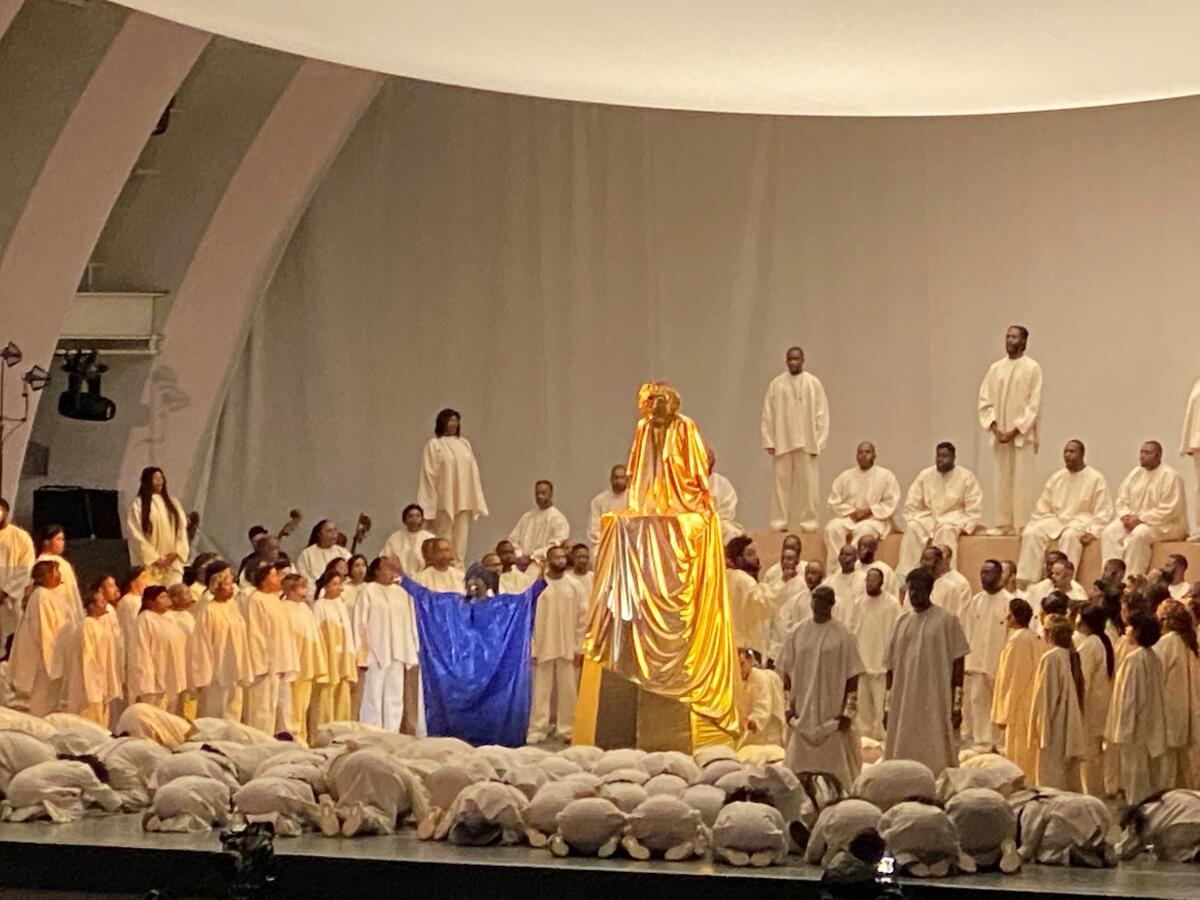
Kanye West premiered his much-anticipated “Nebuchadnezzar” opera Sunday evening at the Hollywood Bowl, and the result was … short! At 50 minutes or so, the production ran for far less than the two hours and change the audience waited (past the advertised 4 p.m. start time) for the show to begin.
But if West’s new project — the latest in a very busy stretch following his pop-up Sunday Service performances, an IMAX concert movie and last month’s “Jesus Is King” album — was surprisingly brief in duration, the scale of it was characteristically ambitious.
Directed by frequent West collaborator Vanessa Beecroft (and streamed live on Tidal), “Nebuchadnezzar” featured a cast of hundreds including dancers, keyboardists, drummers, string players, the Sunday Service choir and, in the title role, rapper Sheck Wes, who wore a shiny indigo-colored outfit in stark contrast with the other performers’ earth-tone robes.
The story — based on the biblical tale of the Babylonian king from the Book of Daniel — clearly grew out of West’s recent religious awakening. But what did it all mean? The Times sent classical music critic Mark Swed and pop music critic Mikael Wood to join what looked like a full house at the Bowl on Sunday, and here they discuss what they saw.
Wood: Kanye seemed very deliberate in using the word “opera” to present “Nebuchadnezzar.” Was it one?
Swed: You can call just about anything an opera, the Latin term for “works,” although for most of us it suggests some sort of dramatic work with music. Even so, what Kanye West has produced with its biblical narration, choral singing and stylized reenactment suggests a passion play, if one from the Old Testament rather than the New.
Wood: Right, basically what we saw was Kanye reading Bible verses — and reading them very dramatically — as his choir delivered long, moody vocal lines without a huge amount of melodic movement. Given the opera designation, I expected more singing from a lead character or two. But that didn’t really happen. Sheck Wes, who played Nebuchadnezzar, growled an awful lot. But the singing we heard didn’t strike me as especially “operatic,” whatever that word means. You?
Swed: Well, there is none of that in “Einstein on the Beach,” either, which is basically repetitive instrumental music, some recitation and movement, with a surreal sense of narrative. But this resembled maybe a combination between an Easter sunrise service at the Bowl and the kind of thing that used to be done at the Pilgrimage Theatre, now the Ford Theatres, across Cahuenga Boulevard. So it at least fit the space historically. How much of this, though, feels like West’s work, especially given the lack of rap?
More than 120 workers at the Museum of Contemporary Art will try to unionize with the American Federation of State, County and Municipal Employees.
Wood: There were connections. At one point I heard a bit of his song “Wolves,” and some of the choral arrangements are definitely in line with what he’s been doing in his Sunday Service performances. But I’m not sure these arrangements did much to showcase the choir. In Sunday Service, the vocals are just incredible — loud, precise, as athletically nimble as they are emotionally stirring. But this stuff felt pretty static. Did the singing impress you?
Swed: I found it hard to tell. The amplification pretty much wiped out the text (some of which was, I think, liturgical Latin). I agree with the sensation of it being static. I would have hoped the gospel influence might have led to more spontaneity, but that was likely the result of how quickly the project was put together. But if the simplicity of the choral writing seemed a perfect background for improvisation, at least the chorus had an impressive collective fervor. What they were singing about, however, was another matter. Could you figure out anything beyond the vague connection with the biblical narration?
Wood: Zilch. If this thing had a story, it was pretty hard to tell. And I agree that the show seemed slapped together in a hurry. When I arrived at the Bowl, I could see stagehands still working on some of the set pieces — mere minutes until showtime. At times, Kanye seemed to be frustratedly directing cast members who didn’t appear to know where they were going — almost a “Waiting for Guffman” vibe. Kanye is famous for not finishing projects until the last possible minute (when he doesn’t blow deadlines altogether). I wonder if that’s a tradition in opera.
Swed: Typically, a new opera is a multiyear project, so the very notion of this pop-up one, which seems to have been in the works for a couple of weeks at most, is extraordinary. But if you go back to the 18th and 19th centuries, operas were popular entertainment put on with the regularity and immediacy that television shows are today. Vivaldi, for instance, wrote around 100 operas, along with thousands of instrumental pieces. Working fast for composers meant anything goes, and cannibalizing their own work and that of others was common. You can only imagine what they were like theatrically.
This then was probably closer to the old days, at least on this scale. And I must say the sense of not knowing what to expect — there was no program, no libretto, West didn’t even use the video screens — added a kind of immediacy that you will never find in a modern opera house. Do you think this is what the crowd expected?
Wood: Good question. I think Kanye’s fans have come to expect the unexpected from him, though I suspect people were probably hoping for something more personal — something that helped explain his enthusiastic embrace of Christianity. (I certainly was hoping for that.) But maybe he liked the idea of stepping outside the traditional performer role to fully become a composer.
He actually maintains a fairly minimal presence in Sunday Service; he lets the choir and his musicians take the spotlight. So I can see this as a natural evolution of that. In addition to religion, of course, Kanye has been talking about politics lately. Does the Nebuchadnezzar figure have any kind of political resonance elsewhere in opera or classical music?
MacArthur fellow and alt-opera wunderkind Yuval Sharon will be interim artistic advisor of Long Beach Opera for the 2021 season. He promises surprise.
Swed: What this Nebuchadnezzar lacked was a strong or original point of view other than mere description. Vanessa Beecroft’s direction was often the processional, though including lovely, moving of bodies. But there is so much more.
Verdi’s fanciful Nebuchadnezzar opera, “Nabucco,” has a strong political message and helped unite Italy. In March, I happened to see a new production in Hamburg by the controversial Russian director Kirill Serebrennikov, who made the Babylonian king a Trump-like figure. The night before in Berlin, I saw Jörg Widmann’s recent opera “Babylon,” full of sex, violence and excess, comparing ancient times with our own.
Here we had the ritual of the Burning Fiery Furnace (a tall, gold-clad figure wheeled out as if in a school play), the king’s madness and all the rest without any interpretation. In the end, it is West’s religiosity, meant to be inspirational on its own without need for a larger context, that makes this “Nebuchadnezzar” seem to intentionally avoid becoming “operatic” and happily content to, as a passion play does, plainly spell out a parable. Ultimately, like you, what I missed was a better sense of West’s personality. His reading had a certain flair. A lot more of that would have helped.
Wood: The problem for Kanye, of course, is that when he wants to be, he’s a great rapper — by turns funny, profane, sentimental and energizing. But this didn’t allow much of his gift to come through. Perhaps he’ll stick with opera and put more of himself in the next one. After all, who’s more operatic a pop star?
L.A.’s Museum of Contemporary Arts starts free admission Jan. 11. Here are 24 more museums that charge nothing on certain days -- or all the time.
More to Read
The biggest entertainment stories
Get our big stories about Hollywood, film, television, music, arts, culture and more right in your inbox as soon as they publish.
You may occasionally receive promotional content from the Los Angeles Times.

